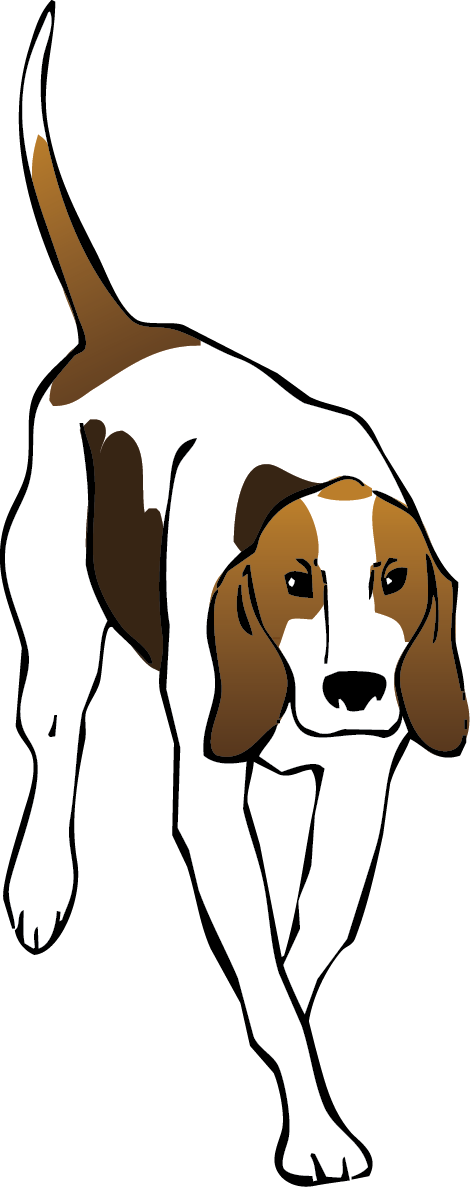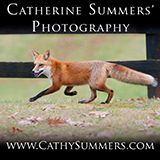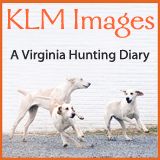Mountain and Muse
Mountain and Muse: A Bicentennial
The Port of Baltimore earned a place in American history two hundred years ago this month during the War of 1812. The British, after burning and sacking Washington, D.C. in August of 1814, turned their attention to Baltimore with an assault by naval and ground troops in September. Francis Scott Key, a witness to the naval bombardment of Fort McHenry, jotted down the words to what became our national anthem, “The Star Spangled Banner.”
The Port of Baltimore earned its place in American foxhunting history that very same month—September, 1814. After the British fleet withdrew to make its final assault of the War of 1812 on New Orleans, a merchant ship entered the Port of Baltimore and disembarked two foxhounds from Ireland, Mountain and Muse.
Unusual for their appearance, speed, aggression, hunting style, and pre-potency, Mountain and Muse turned out to be progenitors of our principal American foxhound strains: July, Birdsong, Trigg, Bywaters, and Walker. The Midland Crossbred, developed by Ben Hardaway, MFH, found today in kennels all over North America as well as England, and having its roots in the July strain, also goes back to Mountain and Muse.
The Hardaway-Morgan-Bell Connection
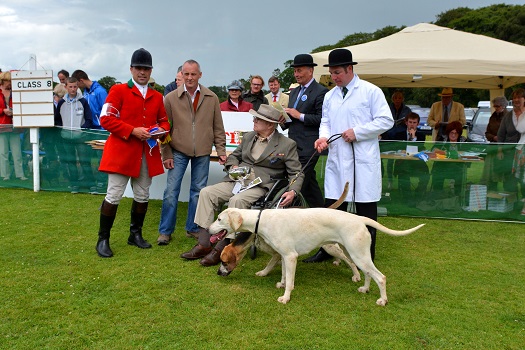 Captain Tom Morgan (seated) presents the Isaac Bell Perpetual Challenge Cup to South Tyrone Foxhounds Honorary Whipper-In Paul Kinane and huntsman Ryan Carvill for Beauty, winning un-entered female hound, at the National Irish Masters of Foxhounds Show. / Noel Mullins photo
Captain Tom Morgan (seated) presents the Isaac Bell Perpetual Challenge Cup to South Tyrone Foxhounds Honorary Whipper-In Paul Kinane and huntsman Ryan Carvill for Beauty, winning un-entered female hound, at the National Irish Masters of Foxhounds Show. / Noel Mullins photo
The above photograph caught my eye because of the man in the wheelchair, Captain Tom Morgan. The photo is one of several sent by photo/journalist and author Noel Mullins, a regular contributor to Foxhunting Life, reporting on the National Irish Masters of Foxhound Show held on Sunday, July 6, 2014.
Captain Morgan, now in his mid-nineties, is one of the few people still alive who intimately knew and worked closely in his hound breeding program with the late Isaac “Ikey” Bell, father of the modern English foxhound. The only other living individual I know who knew and benefitted from his relationship with Ikey Bell is Ben Hardaway, also in his mid-nineties.
If it weren’t for Ikey Bell and Tom Morgan, Ben Hardaway would not have his Hardaway Crossbred as we know it today. And if it weren’t for Bell, we wouldn’t have the modern English foxhound as we know it today.
Foxhunting in North America: A Brief History
Here is a concise history of foxhunting in North America from the seventeenth to the twentieth century, tracing the sport from its Colonial beginnings to organized foxhunting as we know it today. The work constitutes part of the first chapter in A Centennial View, published by the MFHA to commemorate the hundredth anniversary of the establishment of the Association.
George Washington and Lord Fairfax hunting in the Shenandoah Valley
Hunting in the Colonies (1600s to 1775)
If you were a second son to a family of landed gentry living in the English countryside during the seventeenth or eighteenth century, you would have found your prospects considerably dimmer than those of your elder brother. Precluded, through the laws of primogeniture, from inheriting your father’s estate, you might have been tempted by land grants offered by the Colonial governors of Maryland or Virginia to emigrate, settle in the New World, and make your fortune there.
If you had an adventurous soul, you might have packed up your family, children, furniture, and, of course, a few of your foxhounds, and embarked on the voyage. Along with those tangible items, you would have brought your rural culture and a hunting heritage to these Provinces. By carrying on your habitual pursuits, you would make Maryland and Virginia the cradle of North American foxhunting.
What Is a July Hound?
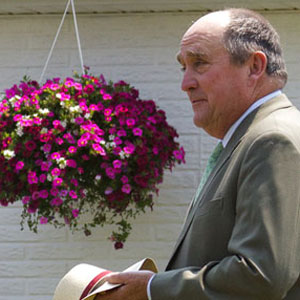 C. Martin Wood III, MFH / Karen Myers photo“Recently I heard the term July hound,” writes Kelly Bryant. “What is a July hound? Is it a breed or a bloodline? How is July blood used in foxhounds today? What benefits do they bring to the hunt, and how does one recognize a July hound from other hounds?”
C. Martin Wood III, MFH / Karen Myers photo“Recently I heard the term July hound,” writes Kelly Bryant. “What is a July hound? Is it a breed or a bloodline? How is July blood used in foxhounds today? What benefits do they bring to the hunt, and how does one recognize a July hound from other hounds?”
Marty Wood, MFH is a member of Foxhunting Life’s Panel of Experts. He is a consummate hound breeder, a student of bloodlines, and breeder of the last two Grand Champion Foxhounds of the Virginia Foxhound Show—2010 and 2011. Your editor has some familiarity with the literature on the July hound, so Wood and Fine collaborated on the answer to Kelly’s question.
